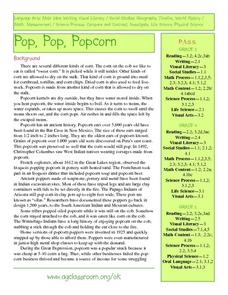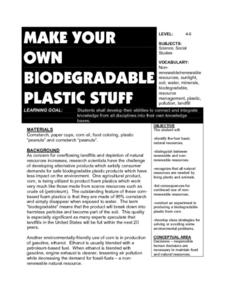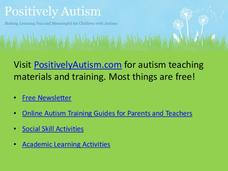Curated OER
Corn-Crop is a Bin-Buster
Learners calculate percent change and create lists of data. They enter the corresponding bushels of corn measured in billions to their list and display, then convert the acres into scientific notation and use the value on the home screen...
American Museum of Natural History
What Do You Know About Virtual Water?
Did you know you can conserve water by drinking tea instead of coffee? Learn about other products that use larger amounts of virtual water in an online lesson. Pupils complete a series of questions to test their understanding of the...
Curated OER
You're Wearing Your Plants!
Students examine the many uses of plants and trees by looking at their clothing. They make lists of products that come from plants and trees and their uses.
Curated OER
Corn Field Math
Learners complete problems dealing with whole numbers, fractions and percents. After exploring the history of corn and related farming vocabulary, students work in pairs to solve multi-step problems. They incorporate the use of number...
Curated OER
Multiplying a Polynomial by a Monomial
In this multiplying polynomials worksheet, students solve and complete 13 different problems that include monomials. First, they use the distributive property to multiply a polynomial by a monomial. Then, students find each product and...
Curated OER
Pop Around the World
Students study the origin of popcorn. They locate countries where it is grown on a world map. They color the world map and glue kernels of popcorn onto the countries from which popcorn originated. They write the names of common items...
Curated OER
Wow! You're Eating Geography
Middle schoolers examine patterns of food producing areas, and identify foods that are grown locally, in the U.S., and around the world. They map and graph the major food crops of their local area, the U.S., and other countries, and...
Curated OER
Kernel Power" Ethanol Fuel from Corn
Students study why corn is a biodegradable, renewable resource. In this ethanol lesson students build models and observe a chemical reaction.
Curated OER
Economics: Products of South Louisiana
Students explore the economy of Louisiana. In this economics lesson, students examine the roles of farmers, processors, and distributors in food production and consumption. Students use flip cameras to record how selected products are made.
Curated OER
Corn Prints and Henri Matisse
Fourth graders observe prints and paintings as the teacher discusses various design elements (repetition, variety, texture, pattern, etc.) used by the artist Henri Matisse. They look at and discuss Indian corn and then make a print that...
Curated OER
Importance of the Rain Forest
Students use the Internet to conduct a research project. In this rain forest lesson plan, students work in groups to research different parts of the rain forest. Students research climate, foods, house products and medicines. Each...
Curated OER
By the Pound
Agriculture surrounds us every day; incorporate measuring tools into a study of Oklahoma's agricultural industry! Small groups read an informational text (included) before visiting stations where they investigate prices of various...
Curated OER
Variation and Heredity
Junior geneticists tally eye color and height in their lab groups. They examine certain traits in soybean and corn seedlings. For each activity, they gather data and learn about continuous and discontinuous genetic variation. In another...
Curated OER
Plant Science Chapter #1
It may not stand as a cohesive presentation, but individually you may find a use for these slides. One slide describes how civilization began once man learned to plant and harvest food. Another explores the population growth over time....
Curated OER
Make Your Own Biodegradable Plastic Stuff
Students identify the four basic natural resources. They distinguish bettween renewable and non-renewable resources. Pupils recognize that all natural resources are needed by living plants and animals. Students list consequences for...
Curated OER
Multiplication Mysteries
Arithmetic apprentices practice problem solving and multiplication with a lift-the-flap pair of reproducibles. In this Halloween mathematics lesson plan, math monsters practice multiplication by making candy corn calculations. They...
Curated OER
Growing from Seed
High school or college horticulturists will appreciate this PowerPoint on seed-propagation. It walks them through the science behind seed production and germination as well as the requirements for growing plants from this stage....
Positively Autism
Thanksgiving Vocabulary
Corn, cornbread, cranberry sauce, family. Introduce learners with autism to 13 vocabulary words associated with Thanksgiving. Each printed word is illustrated and presented against a golden background.
Curated OER
Starch
Learners examine the basics of starch and how it is used in food. In this photosynthesis lesson students experiment with variables that affect starch production in photosynthesis.
Curated OER
Dirt Babies
Dirt babies are an excellent way to show young botanists the plant life cycle. They explore the functions and industry behind grasses before growing some of their own. Use the informational text here and consider implementing some...
Curated OER
Speaking and Listening
What a terrific presentation! It takes learners through a step-by-step explanation to create a new type of chocolate bar, advertise the product, and design a presentation. This is a creative way to get your class writing and thinking...
Positively Autism
Travis the Train Goes on a Summer Picnic
Hamburgers, hot dogs, chips, watermelon, corn on the cob, lemonade. Travis the Train introduces foods and drinks that may be taken on a summer picnic.
Curated OER
Grain Properties Activity
Students study the similarities and differences of five different grains. They analyze the characteristics of corn, sunflower, milo, wheat, and soybeans.
Curated OER
Vegetable Twister
Learners review vegetables and their nutrient values and production. In this vegetable production worksheet, students read information about the nutrients in vegetables and how they are grown. Learners participate in a game of Twister to...

























